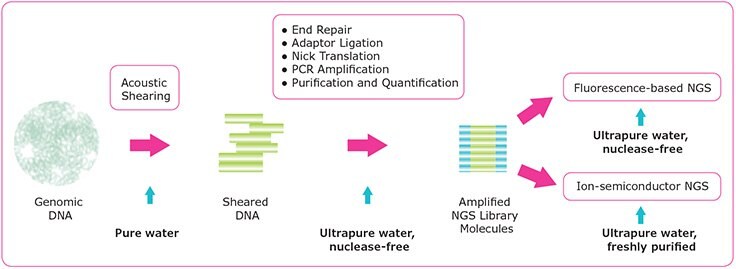Water for Next-Generation Sequencing
Estelle Riche, Stephane Mabic
Millipore S.A.S, Lab Water, Saint-Quentin-en-Yvelines, France
Abstract
Water is used throughout the next-generation sequencing (NGS) workflow, from DNA fragmentation to sequencing runs and instrument cleaning. Using the appropriate water quality for each step will not only eliminate the risk of water contaminants interfering with nucleic acids and the many enzymatic reactions performed in this process, but will also help prevent instrument contamination.
Introduction
Next-generation sequencing (NGS) revolutionized genomic research, and is now playing a crucial role in the clinical environment. NGS-based tests are invaluable in the assessment of new therapeutic drugs, and are increasingly being used for screening, diagnosis, and molecular characterization of cancers and many other diseases. The development of these molecular pathology tools leads the way to personalized care and preventive medicine.1,2 Laboratories conducting high-throughput sequencing rely on high-quality reagents for best results. Water is an essential but often overlooked reagent in the NGS workflow. From system cleaning to sequencing runs, various activities within the NGS workflow require different levels of water quality.
Discussion
The various NGS platforms available today rely on different chemistries and sequencing strategies, but most of them follow a similar workflow (Figure 1). Water quality may affect each step of this workflow.

Figure 1. NGS workflow and specific water quality requirements.
DNA Fragmentation
High-quality sequencing libraries are critical in obtaining reliable NGS data3, and the important first step is DNA fragmentation. If acoustic shearing or sonication is used to fragment DNA, pure, particle-free water, (e.g., from an Elix® system), is recommended for the water bath, since impurities could cause variations in the efficiency of energy transfer to the sample. Water should be changed regularly to limit bacteria growth and reduce the risk of sample contamination.
Nucleic Acid Library Preparation
Water may contain contaminants, albeit in minute amounts, which can directly interfere with DNA and/or with the enzymatic reactions performed during library preparation (e.g., end-repair, ligation, PCR). Enzymatic activity may be affected by traces of organic molecules (humic acids), and ions or metals (magnesium, iron, etc.) that are potentially present in water. In addition, nucleases may degrade samples and should be avoided. Finally, water contaminants such as particles or bacteria may contaminate instruments or deposit into the lines of automated liquid handlers. Therefore, ultrapure water free of nucleases (e.g., from a Milli-Q® system fitted with a Biopak® ultrafiltration polisher) is recommended for these steps.4
For library quantification and quality control, gel, chip-based or capillary electrophoresis may be used. In all cases, optimized migration of the sample with respect to its charge depends on water quality, and fluorescence detection may be disrupted by organic contaminants. Therefore, to ensure reliable results, ultrapure water free of ions and organics (18.2 MOhm·cm resistivity; Total Oxidizable Carbon level at 5 ppb or below) should be used to prepare buffer and capillary gels, and for dilutions.
Next-Generation Sequencing
The sequencing process is highly sensitive to any nuclease activity. Although the impact of nuclease contamination may not be apparent during the initial loading and calibration period, over time the degradation of signal could prove disastrous for experimental results. For this reason, ultrapure water free of nucleases is recommended for buffer dilutions and system-running buffers.
- Fluorescence-based NGS
NGS platforms differ in engineering and in sequencing chemistries, but most of them rely on fluorescence detection. In addition to the aforementioned water contaminants, organic traces must be avoided, as they may affect fluorescence. Indeed, organic contaminants in water could either quench or increase the fluorescent signal, giving erroneous results in both cases.
- Ion semiconductor NGS
This sequencing technology monitors the incorporation of nucleotides by detecting the protons being released.5 The detection, instead of being optical, is therefore performed by precise measurements of changes in pH. This technology is sensitive to any pH change that is not due to the extension of the DNA molecule. Instrument manufacturers specifically recommend the use of freshly purified ultrapure water in order to ensure a pH close to 7. This is due to the fact that, upon storage in contact with the atmosphere, ultrapure water absorbs carbon dioxide and becomes slightly acidic (Figure 2), affecting the sequencing process. For this reason, ultrapure water must be freshly purified and protected from contact with the atmosphere when it is used for ion semiconductor NGS.

Figure 2. Absorption of carbon dioxide by ultrapure water. When ultrapure water is left in contact with the atmosphere, it absorbs carbon dioxide from the air, leading to the production of carbonic acid, carbonate and bicarbonate. The pH of water, initially at 7.0, may drop as low as 5.8.
Conclusion
Water is an essential reagent in NGS and its quality has a direct impact on the consistency and reliability of sequencing results. A well-designed and maintained water purification system can provide laboratories with high-quality water tailored to meet all their specific needs.
Acknowledgments
The authors are grateful to Dr. Sean P. Kennedy, Head of Biomics Pole, Pasteur Institute, Paris, France for his technical support and expertise.
References
如要继续阅读,请登录或创建帐户。
暂无帐户?